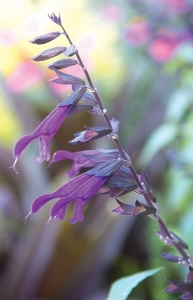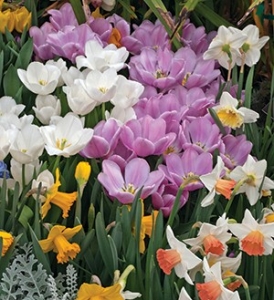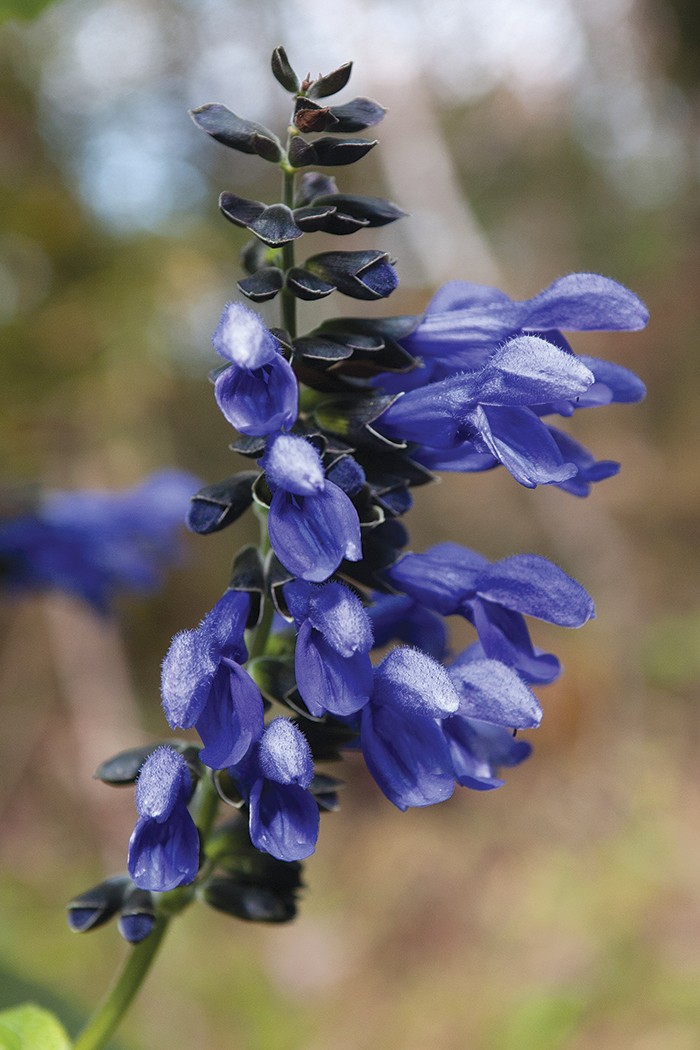When I find a reliably performing plant that is easy to grow, low in maintenance and long lasting in the eye candy department, you can bet the farm it will catch my attention. I’ll give bonus points at the suggestion this bit of greenery smells like one of my past guilty pleasures — black licorice. This leads to a predictable green thumbs up for anise sage.
Botanically known as Salvia guaranitica, anise sage brings a toughness many salvias are known for to just about any garden party, along with the desirable ability to flaunt flowers from spring until the first autumn frosts. An herbaceous perennial that, depending on the cultivar, can reach 3 to 5 feet tall, it will show off impressive stalks of small, conical blooms visually residing in the violet/indigo end of the spectrum, with some cultivars skirting into the range of true blue.

‘Amistad’ is a pleasing purple performer.
As with most perennials, fall is a fine time to plant anise sage. Placed in a well-draining area that receives about six hours of sun a day and, at least for its first year in the garden, watered well when the rains don’t come, this blooming beauty can easily settle into its no-fuss-no-muss mode in almost any landscape setting. And as a double bonus, deer ignore this plant, while butterflies, bees and hummingbirds can’t resist it.
As far as particular cultivars, for me, ‘Black and Blue’ goes to the head of the class. It has been a popular pick for years, and for good reason. Each pretty blue bloom emerges from a midnight black calyx, making for a visual pop to remember.
The recent hybrid introduction ‘Amistad’ is a similar sight sensation, except its flowers have been dipped deeper into pretty purple. As a softer contrast, ‘Argentine Skies’ has green calyxes typical of most anise sages, but its flowers blush in a modest light blue.
There are many other anise sage cultivars available to gardeners, meaning the three I mentioned are just the tip of a pretty iceberg. I have found various selections at local garden centers as well as the State Farmers Market in Raleigh, but anise sage is also an easy find if you prefer to let your fingers do the walking on the internet.
Regretfully, sticking to truth in journalism, I do have to admit that the inedible leaves of my anise sage plants when rubbed, at least to me, really don’t really smell like the licorice whips I devoured as a kid — so I’m not really sure where the anise connection came from. But rather than sing the blues, I enjoy the blues…and the indigos…and the violets of these steadfast plants that dependably doll up my landscape with beautiful blooms through the long growing season.

Spring-blooming bulbs
The beginning of autumn will find garden centers starting to offer their annual selections of fall-planted, spring-blooming bulbs, and while buying early will get you the best selections, planting early could result in a poor flower show next year.
Let the soil cool down so it won’t entice the dormant bulbs to start growing too soon. Usually, late October into November is a good planting time.
Until then, store your bought bulbs in a cool place. The refrigerator makes an ideal “chiller” as long as the bulbs are kept away from ripening fruits. They emit a gas called ethylene that could have detrimental effects on the bulbous sleeping beauties.
To Do in the Garden
September
- The veggie patch isn’t finished yet! There is still time at the beginning of this month to plant such delectable edibles as spinach, lettuce, radishes, kale, onions and mustard greens.
- Ornamental grasses should be coming into their prettiest prime now, with many showing off dazzling inflorescences. Be sure to create a few dried indoor arrangements with the clippings of these beauties this fall.
- For a better display from hellebores this winter and next spring, apply a time-release fertilizer around them now.
- Before you bring houseplants inside for the winter, let the light shine in first. Thoroughly clean any windows that will host these plants to receive more light — meaning more energy — from the weak winter sun.
- Also, tuck soon-to-be indoor houseplants into a shadier spot in the yard for a week or two before they are brought in for the winter. This adjustment period prepares them for the coming times of lesser light inside.
- Saving any planting pots from this growing season for next year? Before you put them in storage, properly prepare the containers by wiping off any dirt and soaking them overnight in a solution of one part bleach to ten parts water.







